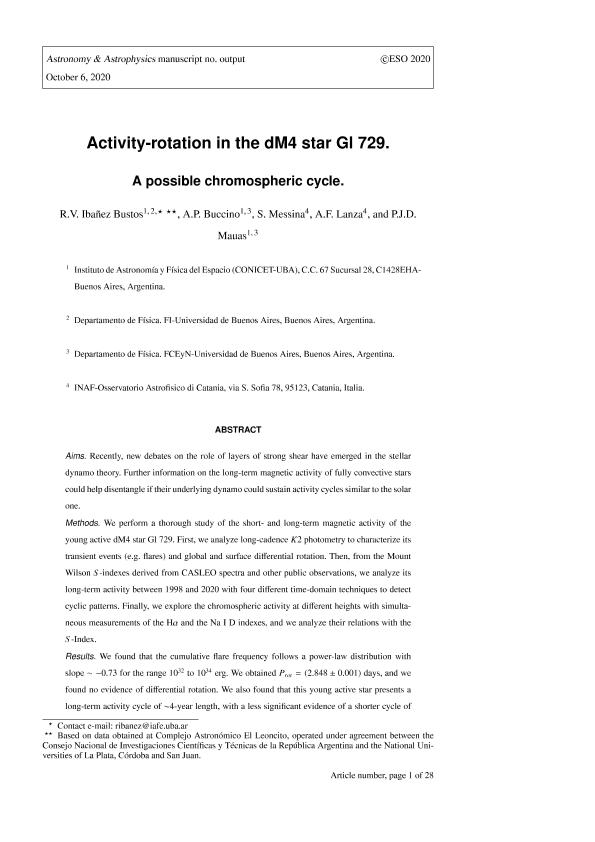Mostrar el registro sencillo del ítem
dc.contributor.author
Ibañez Bustos, Romina Valeria

dc.contributor.author
Buccino, Andrea Paola

dc.contributor.author
Messina, S.
dc.contributor.author
Lanza, A. F.
dc.contributor.author
Mauas, Pablo Jacobo David

dc.date.available
2022-07-19T18:00:33Z
dc.date.issued
2020-11
dc.identifier.citation
Ibañez Bustos, Romina Valeria; Buccino, Andrea Paola; Messina, S.; Lanza, A. F.; Mauas, Pablo Jacobo David; Activity-rotation in the dM4 star Gl 729: A possible chromospheric cycle; EDP Sciences; Astronomy and Astrophysics; 644; 11-2020; 1-14
dc.identifier.issn
0004-6361
dc.identifier.uri
http://hdl.handle.net/11336/162555
dc.description.abstract
Aims. Recently, new debates about the role of layers of strong shear have emerged in stellar dynamo theory. Further information on the long-term magnetic activity of fully convective stars could help determine whether their underlying dynamo could sustain activity cycles similar to the solar one. Methods. We performed a thorough study of the short- and long-term magnetic activity of the young active dM4 star Gl 729. First, we analyzed long-cadence K2 photometry to characterize its transient events (e.g., flares) and global and surface differential rotation. Then, from the Mount Wilson S-indexes derived from CASLEO spectra and other public observations, we analyzed its long-term activity between 1998 and 2020 with four different time-domain techniques to detect cyclic patterns. Finally, we explored the chromospheric activity at different heights with simultaneous measurements of the Hα and the Na I D indexes, and we analyzed their relations with the S-Index. Results. We found that the cumulative flare frequency follows a power-law distribution with slope ~-0.73 for the range 1032-1034 erg. We obtained Prot = (2.848 ± 0.001) days, and we found no evidence of differential rotation. We also found that this young active star presents a long-term activity cycle with a length of about 4 yr; there is less significant evidence of a shorter cycle of 0.8 yr. The star also shows a broad activity minimum between 1998 and 2004. We found a correlation between the S index, on the one hand, and the Hα the Na I D indexes, on the other hand, although the saturation level of these last two indexes is not observed in the Ca lines. Conclusions. Because the maximum-entropy spot model does not reflect migration between active longitudes, this activity cycle cannot be explained by a solar-type dynamo. It is probably caused by an α2-dynamo.
dc.format
application/pdf
dc.language.iso
eng
dc.publisher
EDP Sciences

dc.rights
info:eu-repo/semantics/openAccess
dc.rights.uri
https://creativecommons.org/licenses/by-nc-sa/2.5/ar/
dc.subject
STARS: ACTIVITY
dc.subject
STARS: LATE-TYPE
dc.subject
TECHNIQUES: SPECTROSCOPIC
dc.subject.classification
Astronomía

dc.subject.classification
Ciencias Físicas

dc.subject.classification
CIENCIAS NATURALES Y EXACTAS

dc.title
Activity-rotation in the dM4 star Gl 729: A possible chromospheric cycle
dc.type
info:eu-repo/semantics/article
dc.type
info:ar-repo/semantics/artículo
dc.type
info:eu-repo/semantics/publishedVersion
dc.date.updated
2021-08-20T19:39:35Z
dc.journal.volume
644
dc.journal.pagination
1-14
dc.journal.pais
Francia

dc.description.fil
Fil: Ibañez Bustos, Romina Valeria. Consejo Nacional de Investigaciones Científicas y Técnicas. Oficina de Coordinación Administrativa Ciudad Universitaria. Instituto de Astronomía y Física del Espacio. - Universidad de Buenos Aires. Facultad de Ciencias Exactas y Naturales. Instituto de Astronomía y Física del Espacio; Argentina
dc.description.fil
Fil: Buccino, Andrea Paola. Consejo Nacional de Investigaciones Científicas y Técnicas. Oficina de Coordinación Administrativa Ciudad Universitaria. Instituto de Astronomía y Física del Espacio. - Universidad de Buenos Aires. Facultad de Ciencias Exactas y Naturales. Instituto de Astronomía y Física del Espacio; Argentina
dc.description.fil
Fil: Messina, S.. Osservatorio Astrofisico di Catania; Italia
dc.description.fil
Fil: Lanza, A. F.. Osservatorio Astrofisico di Catania; Italia
dc.description.fil
Fil: Mauas, Pablo Jacobo David. Consejo Nacional de Investigaciones Científicas y Técnicas. Oficina de Coordinación Administrativa Ciudad Universitaria. Instituto de Astronomía y Física del Espacio. - Universidad de Buenos Aires. Facultad de Ciencias Exactas y Naturales. Instituto de Astronomía y Física del Espacio; Argentina
dc.journal.title
Astronomy and Astrophysics

dc.relation.alternativeid
info:eu-repo/semantics/altIdentifier/url/https://www.aanda.org/10.1051/0004-6361/202039164
dc.relation.alternativeid
info:eu-repo/semantics/altIdentifier/doi/http://dx.doi.org/10.1051/0004-6361/202039164
Archivos asociados
